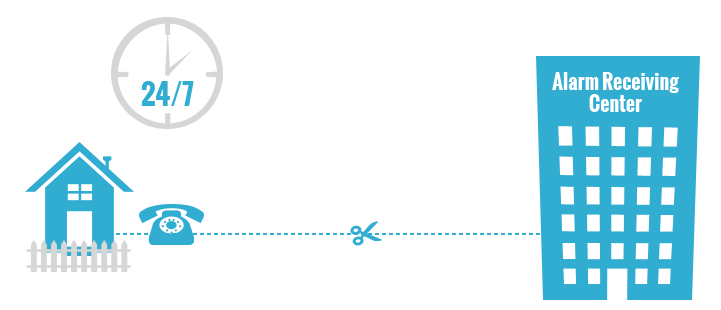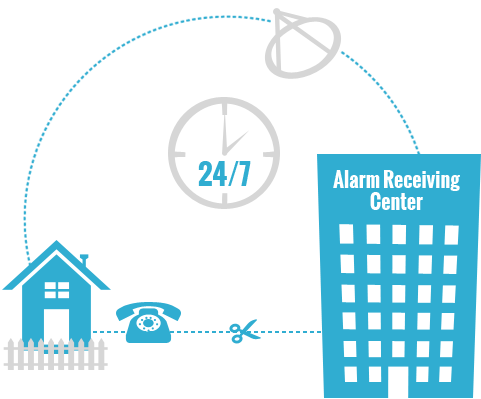Monitored Burglar Alarms
Monitored alarm systems communicate with an Alarm Receiving Centre (ARC). The ARC responds 24/7 to alarm activations by calling your nominated keyholders and police.

Are monitored intruder alarms right for you?
The ARC, often referred to as Central Station in the trade, will use automated software to monitor and respond to alarms, but it will also be staffed, so there's no risk of technology failure preventing notification calls.
For large houses in remote locations, high risk properties, or residential properties that are occupied part time, you may find that a monitored alarm system is a requirement for your home insurance policy. Most commercial premises require this kind of alarm system. If you have particularly valuable items in your house, such as technology equipment, expensive jewellery or you run a business from home with computer storage or specialised equipment, we recommend a monitored intruder alarm system.
There are three ways burglar alarm systems connect to an ARC:
Digital Communicator
Also known as digicoms, these systems were among the first digitally monitored systems to be launched.
Digicoms should ideally use their own dedicated phone line with incoming calls barred. This is to prevent a cunning intruder calling the line to engage it, so that the system can't call out.
The digicom is mounted in the alarm control panel. When the alarm is activated, it dials out to the ARC and sends packets of data in a secure encrypted format that's decrypted by software at the ARC. The ARC will then take appropriate action by notifying key-holders or calling the police.
Pros
- Alarm activations are securely sent to a 24/7 monitored Alarm Receiving Centre that will always respond
- It's relatively cheap to buy the digital communicator and it can be moved with you if you move house
Cons
- You have to pay line rental on a phone line (if you don't have one already)
- You have to pay an annual subscription to the monitoring station (ARC)
- You will need an annual maintenance contract with the alarm installation company
- If the telephone line is cut, then the system will not be able to call out
Get a quick quote for a monitored alarm now. Quick Quote
Single Path Signalling
BT pioneered this system in the 1990s with the launch of the very successful BT Redcare service. Today there are several other reputable suppliers in the market too.
A single path signalling system can dial out using either the GSM mobile network, GPRS mobile data network or a fixed phone line. It can also send more sophisticated information to the ARC. For example, it might report the type of breach, such as a personal attack or standard alarm activation, including the zone triggered within the property.
BT Redcare
A single-path
signalling product
The biggest advantage is that the signalling path itself is monitored.

Pros
- Alarm activations are securely sent to a 24/7 monitored ARC that will always respond
- The signal path is monitored, so any attempt to tamper with it will be notified to the ARC
- It can send out more detailed information than a digital communicator, so keyholders or police are better informed and ready to deal with the situation when they arrive on site
- You can use an existing fixed telephone line, with a cable extending it to the alarm panel
Cons
- You have to pay an annual subscription to the ARC
- If installed on an existing line, you may need to add an ADSL filter which separates digital data transfer from voice
- You need to pay for a monthly SIM card subscription if you choose this communications path
Get a quick quote for a monitored burglar alarm System now. Quick Quote
Dual Path Signalling
Instead of having one channel to communicate with, these systems have a primary and a back-up signalling path.
That means if there's a fault or problem with the primary channel, such as a fixed line, it will automatically use the back-up channel, such as the GSM mobile network.

There are many combinations of signal paths you can choose, combining old and new technologies. Depending on the infrastructure you already have, or are prepared to invest in, you could combine two of fixed line (PSTN), mobile (GSM), GPRS and your broad-band service (IP).
BT Redcare
A dual-path
signalling product
signalling product
CSL
A dual-path
signalling product
Pros
- Alarm activations are securely sent to a 24/7 monitored ARC that will always respond
- Dual signalling gives you added security because of the backup signalling path
- ARC notification within 40 seconds
- Redcare GSM is Grade 4 rated in the European Intruder Alarm Standards, meaning it's suitable for the highest identified level of risk
Cons
- You have to pay an annual subscription to the monitoring station
- You will need an annual maintenance contract with the alarm installation company
- You need two reliable signalling paths
Get a quick quote for a monitored alarm system now. Quick Quote